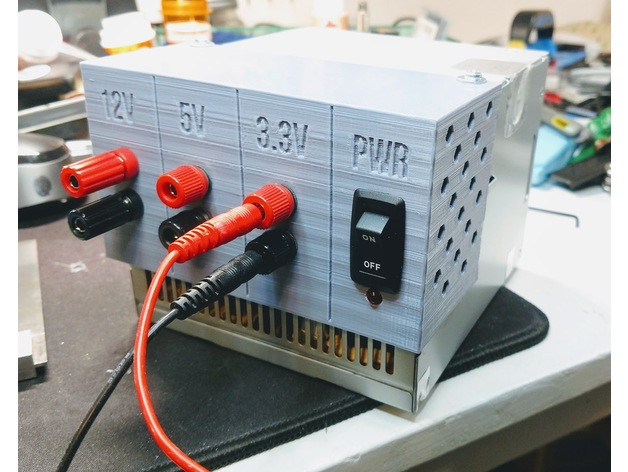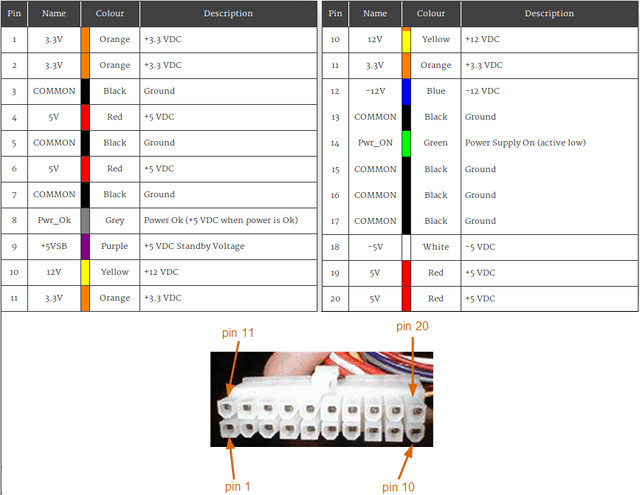You may own one or more old computer towers with an ATX power supply that just gather dust, but since the ATX connector provides +12V, -12V, 5V, 3.3V and GND signal it could be converted into an bench power supply. People have been doing this for a while, but elliotboney’s solution looks neater than most with a 3D printed part that’s attached on top of the power supply.
 Once you have printed the part, which may need to be adapted to to your power supply, you just need a few banana jacks, and a power switch before connecting with the cables:
Once you have printed the part, which may need to be adapted to to your power supply, you just need a few banana jacks, and a power switch before connecting with the cables:
I basically kept 3 wires of each voltage, a 3 black wires for each ground. So 3 yellow for 12V, 3 Red for 5V and 3 Orange for 3V. Any extra wires I cut as close to the board as possible and put a little piece of heat shrink over the cut wires just to prevent shorts.
For the switch, you’ll use the green wire and a ground. Internally, you’ll want to connect the gray wire and an extra 5V (red) wire. This is the power_ok to let the PSU know it’s outputting the correct voltage.
That post clearly explains ATX to bench power supply conversion in details, and provides a ATX connector pinout diagram.
Once all the connections are done, the back of the 3D printed part looks like that:
 Via Adafruit Blog.
Via Adafruit Blog.

Jean-Luc started CNX Software in 2010 as a part-time endeavor, before quitting his job as a software engineering manager, and starting to write daily news, and reviews full time later in 2011.
Support CNX Software! Donate via cryptocurrencies, become a Patron on Patreon, or purchase goods on Amazon or Aliexpress






Oh can i use this technique to power 4 HDDs i plan to make NAS out of using Orange Pi Plus 2E?
I’ve been thinking hard about how to power the 4 disks, as they might need ~40W at startup. Right now i’ve both some 200V to 12V/2A adapters from AliE, but that cannot power all of 4 HDDs.
Some (many) PC internal SMPS’s need a load to operate correctly/safely, especially at start-up. I don’t see this addressed in this project.
@Fossxplorer
Instead of using an overrated PSU (that will consume way to much just by itself) I would look up ‘Staggered spin-up’. Not possible with cheap desktop/consumer grade HDDs so you would have to implement this yourself (using relais or mosfets for the SATA power lines or carefully chosing drives that allow to be configured that way using hdparm).
If you can prevent all 4 disks spinning up at the same time power requirements for somewhat decent 3.5″ HDDs are surprisingly low: If you can measure consumption on 12V and 5V rail individually you’ll see 12V being identical all the time (except some disks rotating at lower speeds when being idle before they enter standby/sleep states) while 5V might increase a lot with random IO activity. At least that’s what I saw when testing several workloads with 2 Seagate Barracuda and a WD Green in an array.
I sort of did this to my pc’s PSU.
I used 5v standby as a usb charger since it is always on, hooked up a aliexpress amplifier to the 12v to amp the aux to my speakers from my broken dvd-hometheather.(alot of static on my speakers though, can also hear my disks spinning)
So useful these PSU’s. You just shouldnt look surprised when it blows up =P
I was powering up a router directly through its 3.3v coming out of an ATX PSU:
https://www.flickr.com/photos/zoobab/5182308547/in/album-72157625284083495/
And that did not worked as expected!
I think it needs some load (like an HDD connected to it) to actually deliver the right 3.3v voltage.
Otherwise, you might also have a look at another breadboard hack for 12V/5V/3.3V/GND:
http://www.zoobab.com/atx-psu-breadboard-mod
This is such a cool idea! Thumbs up; thanks for sharing.
or you use one of these: https://www.aliexpress.com/wholesale?ltype=wholesale&SearchText=atx+power+Breakout
@Ivo
Updated comment to replace shortlink by direct link.
@zoobab
Of course it didn’t work as @Drone already mentioned. You should do a web search for ‘atx psu dummy load resistor’ or even better ‘heatsink atx dummy load resistor’ since for most ATX PSUs to get them output (stable) power for devices with low powering requirements you need to waste (way too much) energy with such a dummy load that generates heat.
If you really must see how well you can cook you electronic gear just look on Aliexpress.
https://www.aliexpress.com/item/DIY-kit-DC-DC-adjustable-step-down-regulator-power-supply-module-with-LCD-display-voltmeter-ammeter/32579067113.html
https://www.aliexpress.com/item/DC-DC-Adjustable-Step-down-Power-Supply-Module-Voltage-Current-Constant-LCD-Display-NC-Buck-Module/32770517230.html
@theguyuk
How do DC-DC step-down converters relate to the (in)efficiency of such an AC-DC ATX PSU brick here? How should measuring at the wrong side of the brick help estimating how much energy such an ATX PSU wastes?
I like this design but this will be more expensive as you have to assemble it yourself and find the parts:
http://b.truzzi.me/new-atx-breakout-board-pcbs-with-some-additions/
This one is interesting as well:
https://oshpark.com/shared_projects/b5F6VhkF
@zoobab
Those may be interesting, but none of them include some sort of case like the one 3D printed in the post.
@theguyuk
Ideal for using all those old laptop power supplies